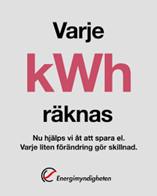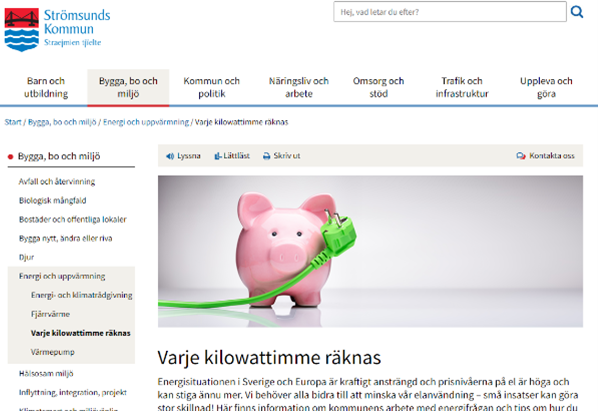Case Study Overview
Several years prior to the energy crisis, the Swedish Energy Agency developed a campaign aimed at reducing electricity consumption if or when the energy situation called for it. As the energy situation worsened in the autumn of 2022, due to Russia’s war on Ukraine, the Energy Agency updated and re-launched this campaign. The primary goal of the campaign was to reduce electricity use, through raising awareness and changing people’s energy consumption habits, and in turn reduce energy shortage risks during winter. The “Every Kilowatt Hour Counts” campaign was aligned with the September 2022 European Union regulation on crisis intervention in the electricity market, which mandated the reduction of electricity use by at least 5% during peak hours and total electricity demand by at least 10%.
Design

Target audience: The campaign primarily targeted the residential sector with a focus on single-family homeowners. The secondary target audiences were business owners and the public sector.
Objectives and message: The campaign had three objectives. The two primary ones were (1) reducing the cost of electricity and (2) reducing the risk of electricity shortages by avoiding consumption at peak hours and reducing strain on the grid. Additionally (3) the campaign aimed to show solidarity between Sweden’s residents and neighbouring countries.
The message of the campaign, “Every Kilowatt Hour Counts” was based on analysis from Svenska kraftnät, a Swedish electricity transmission operator, which showed that the risk of manual load shedding of the electricity was significantly reduced if electricity use dropped by two percent – equivalent to approximately 3 TWh. This is approximately the same potential saving achieved by lowering indoor temperature by one degree and reducing hot water usage by half, in the residential sector.
Resources: Initially, a small group of communication professionals and unit managers led the campaign design, together with an external agency that developed ideas, further text and visuals based on the existing messages and materials. The head of communications and additional unit managers were involved in the decision-making process. A media agency was hired to manage media bookings and publications, in accordance with an established schedule, through various and multiple channels.
Later in the campaign, a task force made up of energy and communication experts was appointed and primed to answer questions on a rolling schedule. External support was sought to measure the outcomes of the campaign, such as the number of clicks and reach, and to conduct an attitude survey to investigate how the campaign was perceived by the public.
The most important lessons learned:
- Hiring an external advertising agency that is unfamiliar with the work of the Energy Agency resulted in several challenges in the initial phase of the campaign and this led to additional time spent on multiple revisions to the campaign’s design.
- Straightforward and formal delegation of decision-making power for the campaign is required at an early stage, as well as the appointment of relevant experts. This can reduce uncertainty about the various responsibilities and simplify decisions on budget, timelines, design, resources, and organisation.
- The workload of designing a campaign, particularly during the initial stages, should not be underestimated. It can be challenging to mobilise the organisational support services when materials need to be produced on short timelines, especially given that supporting staff needs to be well-informed on the background, goals and message of the campaign.
- It is useful to have a point-person for internal information on the campaign and its scope within the Energy Agency.
- Simple and straightforward messages with accompanying illustrations prioritised easy actions. The colours were chosen to soften the message in comparison to a warning campaign. Backing up all messages by facts, verifiable on the Energy Agency’s campaign page, was a factor in the success of the campaign
Implementation
Media channels used: the messages were disseminated through media, digital and print advertising, social media, and the campaign website. Channels included Facebook, Instagram, TikTok, Snapchat, YouTube, digital ads in newspapers and websites, Google ads, TV4 play (single-family homeowners’ campaign), daily newspapers and billboards.
Recommended measures: Recommended measures were designed and formatted to leave no room for interpretation and answered precisely to what individuals can do to save electricity. The most impactful actions were selected and the messages reinforced with visual icons to make the message more accessible. Additional detailed information was also made available on the campaign‘s website.
 Stakeholder involvement: The Energy Agency engaged with municipalities, county administrative boards, other public authorities and electricity companies, who were invited to participate in the campaign.
Stakeholder involvement: The Energy Agency engaged with municipalities, county administrative boards, other public authorities and electricity companies, who were invited to participate in the campaign.
The most important lessons learned:
- Resources: Cross-departmental collaboration among various experts was key to the campaign’s success.
- Media management: Pre-empting questions and responses from the target audience, having them readily available and defining who the response should come from (the Energy Agency or another actor) helped with media management. As for social media, a strategy for dealing with “trolls” would be useful in the future. Establishing clear contact points for the press to ask questions and/or access campaign material was a success factor.
- Stakeholder involvement: Increased cooperation between the Energy Agency, other authorities and the government could help ensure that messages are synchronous and coordinated, and that the authorities keep public trust. Similarly, having a clear contact point to coordinate, inform and receive updates from cooperating governmental bodies could improve the campaign’s success.
Tracking
![]()
Impacts: Website and social media data showed a rising interest in energy, leading to an increase in knowledge that spread throughout society.
Outcomes: The target outcome was not defined prior to the campaign. The issue of efficient energy use was kept alive throughout the campaign in summer 2023. Planning for another potential campaign has already begun, and its timing would depend on the energy situation in Sweden.
Campaign Summary
| Agency | The Swedish Energy Agency |
| Slogan | Every Kilowatt Hour Counts (“Varje kilowattimme (kWh) räknas”) |
| Website | Varje kilowattimme (kWh) räknas Every Kilowatt Hour Counts |
| Contact person | Lena Nordin-Andersson, lena.nordin-andersson@energimyndigheten.se |


